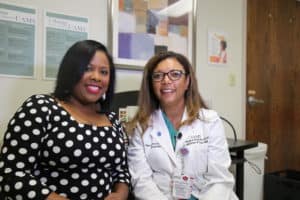Dallas Woman Calls UAMS Fertility Specialist her “Angel Doctor”
| Porsha Hart was diagnosed with uterine fibroids when she was 25 years old. Also known as leiomyomas, fibroids are a benign tumor of smooth muscle found in the uterus.
Hart says they were causing her to have an overactive bladder, heavy bleeding during her menstrual cycles and pelvic pressure.
“I was uncomfortable,” Hart said. “And I knew I was not functioning at my optimal health.”
A few months after she was diagnosed, Hart scheduled surgery to remove the fibroids. But a week before the operation, the physician canceled.
“He called me personally and said if he goes through with the surgery, I won’t be able to have children.”
Hart hopes to one day get married and start a family. She’d been doing research to find a doctor who could remove her fibroids without a hysterectomy. In 2014, she found Gloria Richard-Davis, M.D., a professor in the UAMS Department of Obstetrics and Gynecology. Richard-Davis is board-certified in reproductive endocrinology and infertility. Uterine fibroids is one of her areas of research.
“Uterine fibroids are very common,” Richard-Davis said. “Forty percent of women have them. In African-American w
omen, that number can be as high as 80 percent. That’s a conservative estimate because there lots of women who have fibroids who don’t have symptoms.”
Researchers know there is a genetic component to fibroids and that there are factors that initiate growth, but they’re still working to find out what causes them.
“When I met her initially,” Hart said. “Dr. Richard-Davis asked, ‘What do you want me to do?’ I told her to do whatever she had to do to preserve my fertility. And that’s exactly what she did.”
Richard-Davis says hysterectomy, surgical removal of the uterus, is a common solution for patients with fibroids.
“It’s a less complicated surgery,” she said. “But it’s not ideal for women who have not yet had children.”
For Hart, Richard-Davis did a myomectomy. She removed the fibroids from the uterus. This more conservative approach is also more complex. Once the fibroids are removed, the surgeon has to reconstruct the uterine wall. There’s also a greater potential for blood loss.
“When you look at how fibroids are formed, they look like balls in the uterine walls,” Richard Davis said. “Each dissection can be time-consuming and most women don’t have a single fibroid. They have multiple fibroids.”
Hart says she felt a significant difference immediately.
“The recovery went well, though I had to take it easy,” she said. “The size of my fibroids made the surgery almost like having a cesarean section. But I thank God I was not in a lot of pain and didn’t have to go back to the hospital until my six-week checkup.”
Hart is 37 now and three years post-surgery. She lives in Dallas. She’s earning a doctoral degree in health studies with an emphasis on population health. When she’s not studying, Hart works as a consultant and motivational speaker. She looks forward to one day getting married and having children and is grateful that she does have the ability to carry a child.
“I tell people about Dr. Richard-Davis in speaking engagements everywhere I go. She’s really been a blessing to me.”
“If a young woman is told hysterectomy is her only option, she should seek a second opinion,” said Richard-Davis.
UAMS is conducting a clinical trial evaluating the safety and effectiveness of an oral medication for uterine fibroids. Patients who are experiencing heavy periods are encouraged to call the UAMS Translational Research Institute at 501-526-7665 to find out more about participating.


